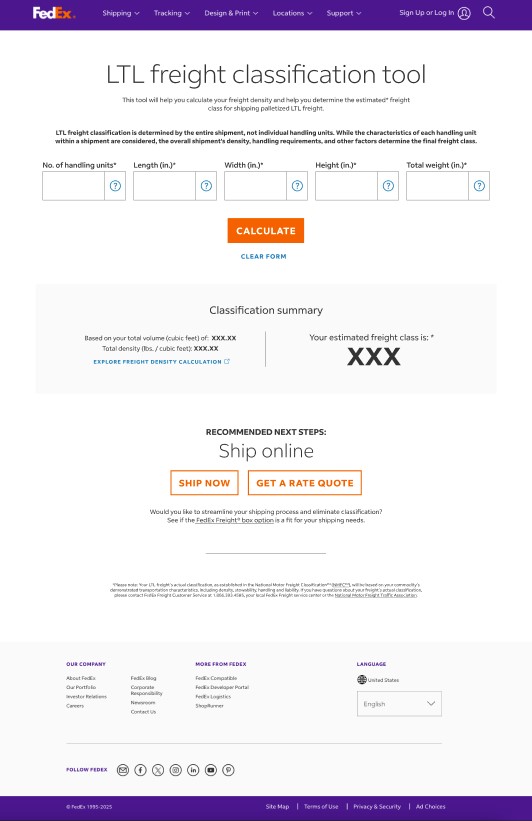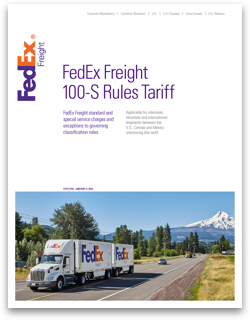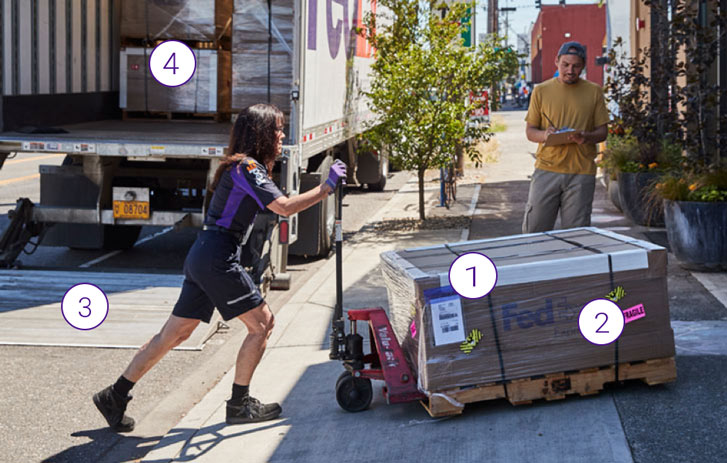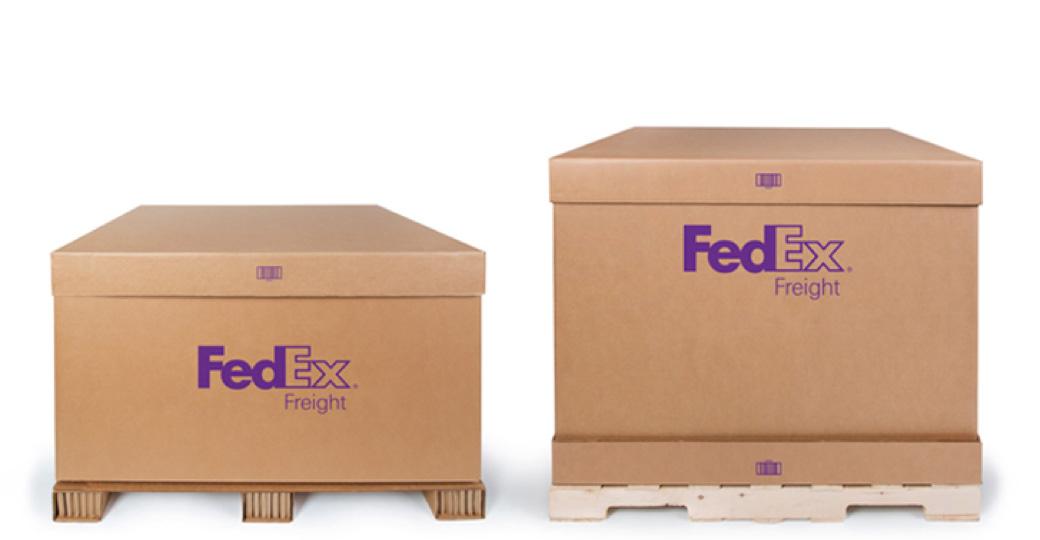
Freight class calculator
Learn about LTL (less-than-truckload) classifications and how to calculate them.
Delayed enforcement of July 2025 NMFC changes
The National Motor Freight Traffic Association (NMFTA) has made changes to many commodities to be more density-based in classification. The most notable changes are the standardization of commodities when density is the primary transportation characteristic. These changes went into effect July 19, 2025, for all carriers that participate in NMFC; however, FedEx Freight is delaying enforcement of the new classifications, allowing customers more time to adjust.
Since several commodities have moved to density-based classification, it’s more important than ever for shippers to accurately record shipments’ density, weight, and dimensions. If you ship these types of commodities, the density determines the classification.
Shippers will see:
- Standardized density scales for LTL freight with no handling, stowability, and liability issues
- Unique identifiers for commodities with special handling, stowability and liability needs
- Condensed and modernized commodity listings
- Improved usability of the ClassIT classification tool through the NMFTA website
To ensure ample time to fully adopt processes and pricing to the new classifications, FedEx Freight is delaying enforcement until December 1, 2025. If you need additional information about the changes and their impact to your business, please refer to the NMFTA website or this resource.
Once the changes are fully adopted, FedEx Freight may apply an inspection surcharge (Item 980, Item 981) for shipments with incomplete or inaccurate information listed on the BOL.
What is an LTL freight class/NMFC code?
Your less-than-truckload (LTL) freight shipping class is a number established by the National Motor Freight Classification (NMFC). It’s also known as your NMFC classification or NMFC code.
Your LTL freight class helps determine your shipping cost.* It’s calculated based on how difficult your commodity is to ship and how much liability is involved.


Classes are an LTL freight shipping industry standard. They’re set by the NMFC tariff, which is a publication for motor carriers containing rules, descriptions and ratings of all commodities.
Why is LTL freight class important?
You’ll need your LTL freight class code in order to get a rate quote or create an online LTL freight shipping label or Bill of Lading.
If you don’t include your LTL freight class, or don’t use the right class, it’s usually caught when your shipment is inspected. Then your class and shipping rates are adjusted accordingly. Incorrect classification may add fees to your shipment costs. See items 980 and 981 in the FXF 100 Series Rules Tariff for more information.
How to determine LTL freight class
LTL freight class is calculated according to your commodity's transportation characteristics, including:
Density — How much it weighs in relation to its size
Liability — Its value and whether extra security precautions are needed to safeguard it against theft
Handling — If it requires special loading equipment or precautions
Stow-ability — How it fits in the trailer with other freight
How to calculate density:
Length: L
Width: W
Height: H
L x W x H =
Cubic
inches
L x W x H =
Cubic
inches
Cubic inches ÷ 1,728 =
Cubic
feet
Cubic inches ÷ 1,728 =
Cubic
feet
Weight (lbs) ÷ Cubic feet =
Density
Weight (lbs) ÷ Cubic feet =
Density
|
Sub |
Density range |
Class |
|---|---|---|
|
1 |
Less than 1 |
400 |
|
2 |
1 but less than 2 |
300 |
|
3 |
2 but less than 4 |
250 |
|
4 |
4 but less than 6 |
175 |
|
5 |
6 but less than 8 |
125 |
|
6 |
8 but less than 10 |
100 |
|
7 |
10 but less than 12 |
92.5 |
|
8 |
12 but less than 15 |
85 |
|
9 |
15 but less than 22.5 |
70 |
|
10 |
22.5 but less than 30 |
65 |
|
11 |
30 but less than 35 |
60 |
|
12 |
35 but less than 50 |
55 |
|
13 |
50 or greater |
50 |
| Sub | Density range | Class |
|---|---|---|
| 1 | Less than 1 | 400 |
| 2 | 1 but less than 2 | 300 |
| 3 | 2 but less than 4 | 250 |
| 4 | 4 but less than 6 | 175 |
| 5 | 6 but less than 8 | 125 |
| 6 | 8 but less than 10 | 100 |
| 7 | 10 but less than 12 | 92.5 |
| 8 | 12 but less than 15 | 85 |
| 9 | 15 but less than 22.5 | 70 |
| 10 | 22.5 but less than 30 | 65 |
| 11 | 30 but less than 35 | 60 |
| 12 | 35 but less than 50 | 55 |
| 13 | 50 or greater | 50 |
There are 18 classes, numbered 50 to 500. A lower class number generally means a lower shipping
cost — because your item is easier to ship.
There are 18 classes, numbered 50 to 500. A lower class number generally means a lower shipping cost — because your item is easier to ship.
|
|
Note: When you ship items with different classes on the same pallet, the shipment defaults to the highest class of those items. For example, if you're shipping car accessories (class 60) with car covers (class 100) on the same pallet, the entire pallet is class 100. |
|---|
Note: When you ship items with different classes on the same pallet, the shipment defaults to the highest class of those items. For example, if you're shipping car accessories (class 60) with car covers (class 100) on the same pallet, the entire pallet is class 100.
How to use our LTL freight class and density calculator
STEP 1
Head to our FedEx LTL Freight Classification Tool. It’s an easy LTL freight class/NMFC code lookup tool with a freight density calculator built in that can help you estimate your LTL freight class.
STEP 2
Measure your freight and enter the length, width, height and shipment weight.
Note:
- When you weigh your shipment, include the pallet or other packaging.
YOUR LTL FREIGHT CLASS CALCULATOR RESULTS
Your estimated LTL freight class number* will be displayed on the screen. As mentioned above, there are 18 classes, numbered 50 to 500. Your actual class will be based on your commodity’s demonstrated transportation characteristics.


Once you've determined your LTL freight class, take the next step.
How to ship LTL freight with flat rates and without having to classify your shipment**
The FedEx Freight® box gives you flat-rate shipping and more security. And because you don’t have to add an LTL freight class, you can combine different commodities when you ship. Plus, you get the flexibility of two size options and fast, easy freight packing.
If you have questions about your LTL freight’s class, please call FedEx Freight Customer Service at 1.866.393.4585 or your local FedEx Freight service center.
*Please note: Your LTL freight’s actual classification, as established in the National Motor Freight Classification™ (NMFC™), will be based on your commodity’s demonstrated transportation characteristics, including density, stowability, handling and liability. If you have questions about your LTL freight’s actual classification, please contact FedEx Freight Customer Service at 1.866.393.4585, your local FedEx Freight service center or the National Motor Freight Traffic Association.
**Flat rates based on zone pricing. Find rates and zone information. Rates are subject to the General Rate Increase (GRI), and all accessorial charges in the FedEx Freight 100 Rules Tariff will apply. Exception: Item 404 (absolute minimum charge) will not apply as the FedEx Freight box is not discountable. Pricing is subject to the standard FedEx Freight 100 fuel surcharge. Use of the FedEx Freight box will supersede any negotiated pricing. Maximum liability is $7.50 per lb. Alaska, Hawaii, Puerto Rico, Canada and Mexico are not covered by FedEx Freight box rates. Hazardous materials are prohibited. Maximum weight allowed for each freight box is 1,200 lbs.





